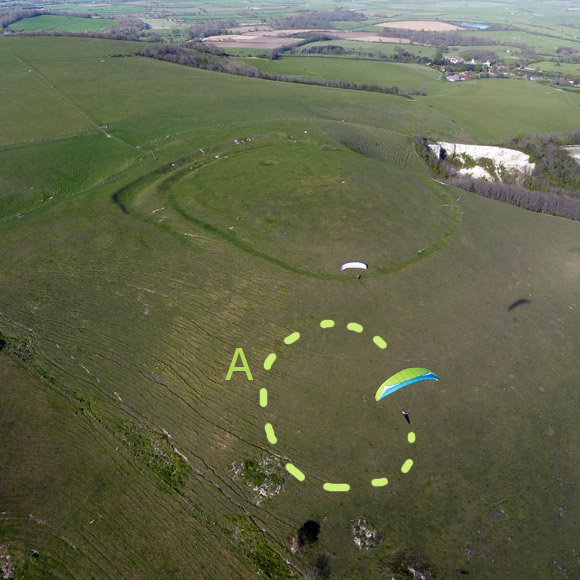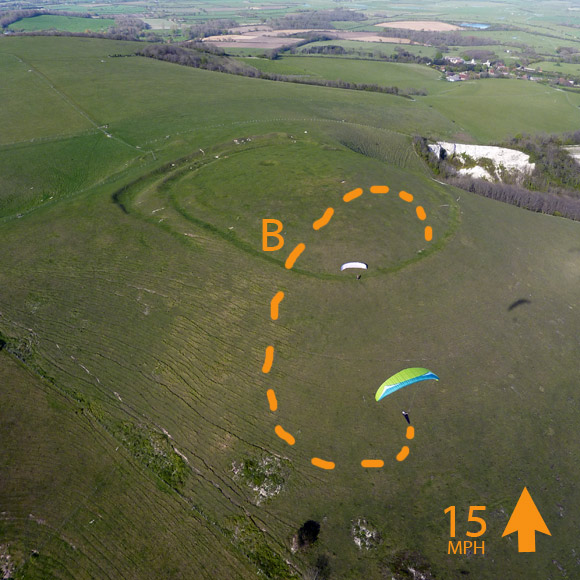When soaring, it's safest to keep all turns away from the hill. But for XC you need to thermal, and effective thermaling requires circling. When you're close to the terrain, you can be caught by the 'downwind devil', especially in strong wind. This has caught out many pilots over the years, pilots who knew the theory and yet still made the mistake. It might not be as simple as it seems. Don't let it catch you!
Here's how it works:
When you are further away from the ridge and facing into wind, it seems that you're turning very tightly because you turn in a relatively small arc over the ground. But as you turn downwind and head towards the hill, it appears to rush up to you. The sudden increase in ground speed and turn radius can easily trick you into applying too much control in an effort to turn in a tighter arc over the ground, and you can accidentally spin, close to the hill. This is very dangerous!

There’s Nancy, demonstrating a perfect thermaling 360 in zero wind conditions on Mount Caburn. The photo is taken looking back at the launch site. When she reaches point A (facing the hill) her closing speed is 20mph (rough speed of partially braked wing). She can complete the turn with ample room to spare.
Now add a normal strong soaring wind of 15mph. Her turning circle becomes a long loop. When reaching point B, the closing speed is now 35mph. And there’s nowhere near enough room to complete the turn, due to the drift.

It’s at point B that the downwind devil strikes. Pilots panic and brake too hard.
There are some contributing factors that make it even worse.
1. As you fly close in to the hill, you descend into the lowest layer of air, which is turbulent due to ground obstacles upwind (trees), thermals, and on very steep ridges or over cold ground, wind shear. Turbulence always messes up your turning, because it disturbs the airflow over your control surfaces. So you can expect your turn to take longer.
2. As you fly close to the crest of the hill, the wind accelerates due to the venturi effect. So at Point B you get a boosted windspeed, maybe 20mph.
3. As you fly close to the hill, you enter stronger ridge lift which causes a temporary vertical component to the relative airflow. As you enter lift, your wing hangs back slightly. A small effect but enough to delay your turn by half a second and put your wing slightly closer to stall point.
4. If you approach the lower part of the hill, you could descend into slower-moving air (wind gradient) which will cause your wing to hang back slightly when going downwind.
5. As you pull hard on the inside brake, the high resistance rolls your body weight out of the turn, causing your wing to level out. Most wings have increasing brake pressure, especially EN A and EN B wings, especially near stall point!
All of these factors combine to delay your turn. The stronger the wind, the harder the downwind devil bites!
How to avoid this disaster:
1. Don’t turn completely towards the ridge when below it. Reverse the turn direction and use a pattern of figure 8 turns to climb.
2. Use strong weight shift in turns. You will need less brake to turn, so you have some more brake instantly available if needed.
3. Learn where the point-of-spin is on your wing (with lots of altitude, or even better, during an SIV course).
4. Push upwind to make more space between you and the ridge.
Want to see more? There’s no better way to support our efforts than buying from us. We’ll ensure you get great service! Choose from our huge range AND enable us to produce more videos and articles to benefit the freeflight community.

